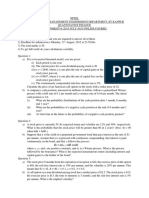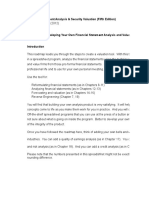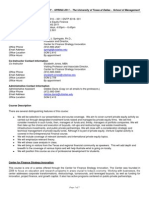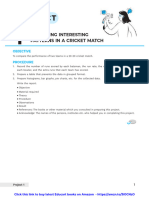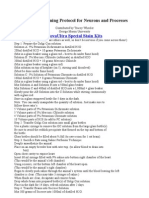Science Inquiry Rubric
Science Inquiry Rubric
Uploaded by
Pasheena RamathasCopyright:
Available Formats
Science Inquiry Rubric
Science Inquiry Rubric
Uploaded by
Pasheena RamathasOriginal Description:
Original Title
Copyright
Available Formats
Share this document
Did you find this document useful?
Is this content inappropriate?
Copyright:
Available Formats
Science Inquiry Rubric
Science Inquiry Rubric
Uploaded by
Pasheena RamathasCopyright:
Available Formats
Science Inquiry/Investigation Rubric
Criteria Meets Standard Beginning to Meet Standard Doesn’t Yet Meet Standard
Asks “testable” questions Poses questions based on Asks questions that may or may
based on observations; re- observations. Identifies one not relate to observations. Does
states untestable questions. Variable. Does not consistently not identify a variable. Does not
Identifies variables. distinguish between questions distinguish between questions
Questioning Distinguishes between that can be answered through that can be answered through
questions that can be observation, experiments, and observation, experiments, and
answered through research. research.
observation, experiments,
and research.
Uses logical inferences to Uses logic to make a prediction Not yet able to generate a
predict what may happen or but does not relate it to evidence. hypothesis or logical prediction.
Predicting &
be observed or provides a
Hypothesizing
reasonable hypothesis
related to evidence.
Student can create a plan Student can develop a fair test Student cannot yet develop a
for a fair test that identifies that includes some of the fair test.
what they will observe and elements of a fair test.
Designing an
measure, includes a
Experiment/
materials list and sequential
Investigation
steps, and describes
variables and how all but
one will be kept constant.
Follows a plan for the Follows a plan for the Does not follow the plan for the
investigation. Records all investigation. Records some data investigation. Records some
data systematically and but not always systematically or data, but not systematically or
accurately. Records accurately. Records observations accurately. Records some
observations of similarities but not always similarities and observations. Does not always
Investigating and differences. Chooses differences. Chooses appropriate choose appropriate
appropriate measurements measurements but doesn’t always measurements. Draws
and measures accurately. measure accurately. Draws scientifically, but not with many
Draws scientifically with scientifically with proper details.
proper perspective and with perspective and with details as
details as necessary. necessary.
Represents data using Represents data using graphs, Does not represent data in an
graphs, charts, and tables. charts and tables, but may not organized manner. Analyzes
Analyzes data based on have chosen appropriate ones. data but does not base analysis
Analyzing and evidence and results of the Analyzes data based on evidence on results/evidence. Explains
Explaining Data, investigation. Explains data and results of the investigation. data but does not use scientific
Drawing using scientific terminology. Explains data using some terminology. Does not use
Conclusions Uses resources to support scientific terminology. Uses resources to support
explanation. Identifies resources to support explanation. explanation. Cannot identify
problems/flaws with the Cannot identify problems/flaws problems/flaws with the
experimental design. with the experimental design. experimental design.
Considers audience in Communicates a general Communication about
selecting what and how to description of their plan and investigation lacks key
communicate. findings, but omits details about components, clarity, and detail.
Communicating Communicates questions, the data collection and analysis
Investigations investigation plan, data process. Is challenged to critique
and Results collection and analysis, and investigation.
conclusions with accuracy
and clarity. Critiques own
investigation and others.
Adapted from a rubric created for the “Journey North” website, Annenberg Media 1997 -2007
You might also like
- Corporate Banking PrimerDocument5 pagesCorporate Banking PrimerJashaswiBiswasNo ratings yet
- DCF Valuation Model (Complete)Document17 pagesDCF Valuation Model (Complete)mohahossam1992No ratings yet
- Foundational Theories and Techniques for Risk Management, A Guide for Professional Risk Managers in Financial Services - Part II - Financial InstrumentsFrom EverandFoundational Theories and Techniques for Risk Management, A Guide for Professional Risk Managers in Financial Services - Part II - Financial InstrumentsNo ratings yet
- Gra 65141 - 202020 - 01.12.2020 - QPDocument4 pagesGra 65141 - 202020 - 01.12.2020 - QPHien NgoNo ratings yet
- Cfroi HoltDocument7 pagesCfroi Holtamro_baryNo ratings yet
- Corporate Finance Interview Questions Excel TemplateDocument8 pagesCorporate Finance Interview Questions Excel TemplateExtreme TourismNo ratings yet
- Centerview Partners January 2023 InternshipsDocument1 pageCenterview Partners January 2023 Internshipscharles alcaideNo ratings yet
- BellCast Pre-MBA Recruiting Guide - 2021Document11 pagesBellCast Pre-MBA Recruiting Guide - 2021Rohan JohnNo ratings yet
- Science Summary RubricDocument2 pagesScience Summary RubricSteven OlenchekNo ratings yet
- Parzen Stat104 Syllabus FALL 2017V6 Campus V4 PDFDocument8 pagesParzen Stat104 Syllabus FALL 2017V6 Campus V4 PDFhwangj3No ratings yet
- Fixed Income Assignment 4Document4 pagesFixed Income Assignment 4Rattan Preet SinghNo ratings yet
- Managing Director Insurance M&A Advisory in Hong Kong Resume John SpenceDocument3 pagesManaging Director Insurance M&A Advisory in Hong Kong Resume John SpenceJohnSpence2No ratings yet
- Barclays AssessmentDocument9 pagesBarclays AssessmentAnonymous 1aCZDEbMMNo ratings yet
- Quantitative Finance PDFDocument2 pagesQuantitative Finance PDFaishNo ratings yet
- IBIG 04 08 Natural Resources Questions Answers PDFDocument34 pagesIBIG 04 08 Natural Resources Questions Answers PDFEmanuil SirakovNo ratings yet
- Finance Interview QuestionsDocument3 pagesFinance Interview Questionsk gowtham kumarNo ratings yet
- Seeking The Sacred in Contemporary Religious ArchitectureDocument104 pagesSeeking The Sacred in Contemporary Religious ArchitectureMuhammad Atif UsmaniNo ratings yet
- Manu Kant: Executive SummaryDocument6 pagesManu Kant: Executive SummarymanukleoNo ratings yet
- Science RubricsDocument38 pagesScience RubricsMohamed Abd el salam100% (1)
- Junior Investment Analyst (JIA)Document3 pagesJunior Investment Analyst (JIA)ديفولوبرز للإستشارات والتدريبNo ratings yet
- Libor Market Model JoshiDocument2 pagesLibor Market Model JoshiquarkcharmerNo ratings yet
- Malibu Boats Inc (DCF + Valuation)Document5 pagesMalibu Boats Inc (DCF + Valuation)Linh Linh NguyễnNo ratings yet
- Fixed-Income Arbitrage-Free Valuation Framework (Binomial Tree)Document32 pagesFixed-Income Arbitrage-Free Valuation Framework (Binomial Tree)Shriya JanjikhelNo ratings yet
- Writing A Journal Article: Guidance For Novice Authors: Continuing Professional DevelopmentDocument8 pagesWriting A Journal Article: Guidance For Novice Authors: Continuing Professional DevelopmentRajkumar35No ratings yet
- Financial Statement Analysis & Security Valuation (Fifth Edition)Document46 pagesFinancial Statement Analysis & Security Valuation (Fifth Edition)arunjangra566No ratings yet
- Markov ModelDocument5 pagesMarkov Modelsomerandomuser2No ratings yet
- Black LittermanDocument21 pagesBlack LittermanJoseph TanNo ratings yet
- Importing Text File in RDocument28 pagesImporting Text File in RRajkumar35No ratings yet
- UT Dallas Syllabus For Fin6316.001.11s Taught by David Springate (Spring8)Document7 pagesUT Dallas Syllabus For Fin6316.001.11s Taught by David Springate (Spring8)UT Dallas Provost's Technology GroupNo ratings yet
- Current Edition Contains: 1: A Couple of Notes On EuropeDocument11 pagesCurrent Edition Contains: 1: A Couple of Notes On EuropeJan KaskaNo ratings yet
- Vault-Finance Practice GuideDocument126 pagesVault-Finance Practice Guidesarthak.ladNo ratings yet
- Investment TheoryDocument29 pagesInvestment Theorypgdm23samamalNo ratings yet
- Accounting Clinic IVDocument36 pagesAccounting Clinic IVPrabowoNo ratings yet
- Short Notes 23-34Document74 pagesShort Notes 23-34Syed Abdul Mussaver ShahNo ratings yet
- Science RubricDocument1 pageScience Rubricapi-321480965No ratings yet
- Impact of Recent Innovation and Entrant On Traditional BanksDocument19 pagesImpact of Recent Innovation and Entrant On Traditional BanksKasim KhanNo ratings yet
- Cfa Mnemonic S Level 1 Sample PDFDocument19 pagesCfa Mnemonic S Level 1 Sample PDFSohail Merchant100% (1)
- The Leveraged Buy Out Deal of TataDocument7 pagesThe Leveraged Buy Out Deal of TataPPTDATANo ratings yet
- Activist Investing Intro Slides Day 1Document19 pagesActivist Investing Intro Slides Day 1ZacharyNo ratings yet
- Mathematics For FinanceDocument27 pagesMathematics For Financekurou hazamaNo ratings yet
- Treynor Black Model: Index (M) 0.08 0.0036 1.3333 Securities 1 0.02 0.2 0.0004 2 0.02 0.3 0.0016 3 0.01 0.6 0.0025Document4 pagesTreynor Black Model: Index (M) 0.08 0.0036 1.3333 Securities 1 0.02 0.2 0.0004 2 0.02 0.3 0.0016 3 0.01 0.6 0.0025MS NagNo ratings yet
- MBA 406 Syllabus Fall 2011Document13 pagesMBA 406 Syllabus Fall 2011Syed Fahad AhmedNo ratings yet
- AdviceDocument16 pagesAdviceanon-323978No ratings yet
- BAFI507 FT2017 Syllabus PikulinaDocument10 pagesBAFI507 FT2017 Syllabus Pikulinauygh g100% (1)
- Finance Interview OutlineDocument4 pagesFinance Interview OutlineYixin TangNo ratings yet
- Investment Banking Valuation - Equity Value - and Enterprise ValueDocument18 pagesInvestment Banking Valuation - Equity Value - and Enterprise ValuejyguygNo ratings yet
- IBIG 04 01 Core ConceptsDocument32 pagesIBIG 04 01 Core ConceptsKrystleNo ratings yet
- Ira Sohn - EBAY Dylan AdelmanDocument23 pagesIra Sohn - EBAY Dylan AdelmansuperinvestorbulletiNo ratings yet
- Indonesia Loss Reserving (Example)Document6 pagesIndonesia Loss Reserving (Example)Setyo Tyas JarwantoNo ratings yet
- KeyBank First Niagara MA DiscussionDocument12 pagesKeyBank First Niagara MA Discussionsambaran PGPM17No ratings yet
- Capm and AptDocument10 pagesCapm and AptRajkumar35No ratings yet
- Estimation Question TipsDocument6 pagesEstimation Question Tipswizz3rNo ratings yet
- Investment Banking Investment Banking2122Document16 pagesInvestment Banking Investment Banking2122vishal13889100% (2)
- Mscfe 622 Continuous-Time Stochastic Processes - Course SyllabusDocument1 pageMscfe 622 Continuous-Time Stochastic Processes - Course SyllabusAbdullah AbdullahNo ratings yet
- Syllabus-WQU601 Financial Markets 1Document15 pagesSyllabus-WQU601 Financial Markets 1gtNo ratings yet
- Mayur Lalchand: Selection Process - An Aptitude Test, Followed by A Write Up, A GD, and & InterviewsDocument6 pagesMayur Lalchand: Selection Process - An Aptitude Test, Followed by A Write Up, A GD, and & InterviewsCHEMICALNo ratings yet
- Venture Debt Course PresentationDocument161 pagesVenture Debt Course PresentationazkashabrinaNo ratings yet
- Private Equity: Corporate Financial Strategy 4th Edition DR Ruth BenderDocument21 pagesPrivate Equity: Corporate Financial Strategy 4th Edition DR Ruth BenderAin roseNo ratings yet
- Performance Evaluation of Mutual Funds in Pakistan For The Period 2004-2008Document13 pagesPerformance Evaluation of Mutual Funds in Pakistan For The Period 2004-2008Mustafa ShabbarNo ratings yet
- PEI FundSupp JPMorganDocument5 pagesPEI FundSupp JPMorganShawnDurraniNo ratings yet
- Antiglaucoma DrugDocument18 pagesAntiglaucoma DrugFoungZanz D. LuffyzNo ratings yet
- The Launch of The EuroDocument13 pagesThe Launch of The Euromai.hnx4205No ratings yet
- Crucial Bx500 SSD ProductflyerDocument2 pagesCrucial Bx500 SSD Productflyervinothagan777No ratings yet
- (Your Business Name Here) - Safe Work Procedure Manual Metal Arc WelderDocument1 page(Your Business Name Here) - Safe Work Procedure Manual Metal Arc WelderSafety DeptNo ratings yet
- Worm and Worm WheelDocument8 pagesWorm and Worm WheelMBilal MughalNo ratings yet
- Merging Multimedia, Controls and Plug - Ins WithDocument17 pagesMerging Multimedia, Controls and Plug - Ins Withammu_20130% (1)
- Industry Day - Code 70 Slides 2.25.14Document11 pagesIndustry Day - Code 70 Slides 2.25.14N TNo ratings yet
- SITXINV003 Assessment Task Purchase GoodsDocument42 pagesSITXINV003 Assessment Task Purchase GoodsIrtaqa RazaNo ratings yet
- Research EssayDocument14 pagesResearch EssayDhara RakholiyaNo ratings yet
- LIFEBUOYDocument12 pagesLIFEBUOYBobyNo ratings yet
- G+2 NewDocument1 pageG+2 New39 - Deep MandokarNo ratings yet
- Class 9 Maths Project and Group ActivityDocument18 pagesClass 9 Maths Project and Group ActivitySanjit PaulNo ratings yet
- Gershwin American in Paris Cor - AnglaisDocument8 pagesGershwin American in Paris Cor - AnglaisDavid AllenNo ratings yet
- Confined SpacesDocument38 pagesConfined SpacesKilli Ndutz SuperHolicNo ratings yet
- CV Budiawan Februari 2024Document15 pagesCV Budiawan Februari 2024BudiNo ratings yet
- Group 2 Project ReportDocument70 pagesGroup 2 Project ReportBijaya RaulaNo ratings yet
- Wapda Ots JobDocument2 pagesWapda Ots JobHassan AliNo ratings yet
- Year 9 Study Guide ChemistryDocument15 pagesYear 9 Study Guide Chemistryreem halawiNo ratings yet
- Yeast and Mold Spoilage in Dairy ProductsDocument4 pagesYeast and Mold Spoilage in Dairy ProductsAngelica Alejandra De La Torre AnayaNo ratings yet
- PreviewDocument91 pagesPreviewStoie GabrielNo ratings yet
- Golgi-Cox Staining Protocol For Neurons and Processes: Novaultra Special Stain KitsDocument3 pagesGolgi-Cox Staining Protocol For Neurons and Processes: Novaultra Special Stain KitstetrazolamNo ratings yet
- E BusinessDocument336 pagesE BusinessMainak SenNo ratings yet
- Chemistry (Determination of Contents of Cold Drinks) - 1Document22 pagesChemistry (Determination of Contents of Cold Drinks) - 1StudenrtNo ratings yet
- Karta Pracy B2 No 2Document2 pagesKarta Pracy B2 No 2Maria GeltzNo ratings yet
- Peripheral Standardisation SIMATIC CFU enDocument39 pagesPeripheral Standardisation SIMATIC CFU enludwig kesslerNo ratings yet
- H6M-P30 (B3) / H6M-P25 (B3) / H6M-P22 (B3) Series: MS-7680 (v5.x) MainboardDocument155 pagesH6M-P30 (B3) / H6M-P25 (B3) / H6M-P22 (B3) Series: MS-7680 (v5.x) MainboardЮрій РудийNo ratings yet
- Awaken The Giant Within2Document9 pagesAwaken The Giant Within2juan72100% (2)
- Managing Organisational BehaviourDocument12 pagesManaging Organisational BehaviourAlexander Frahm-FetherstonNo ratings yet













